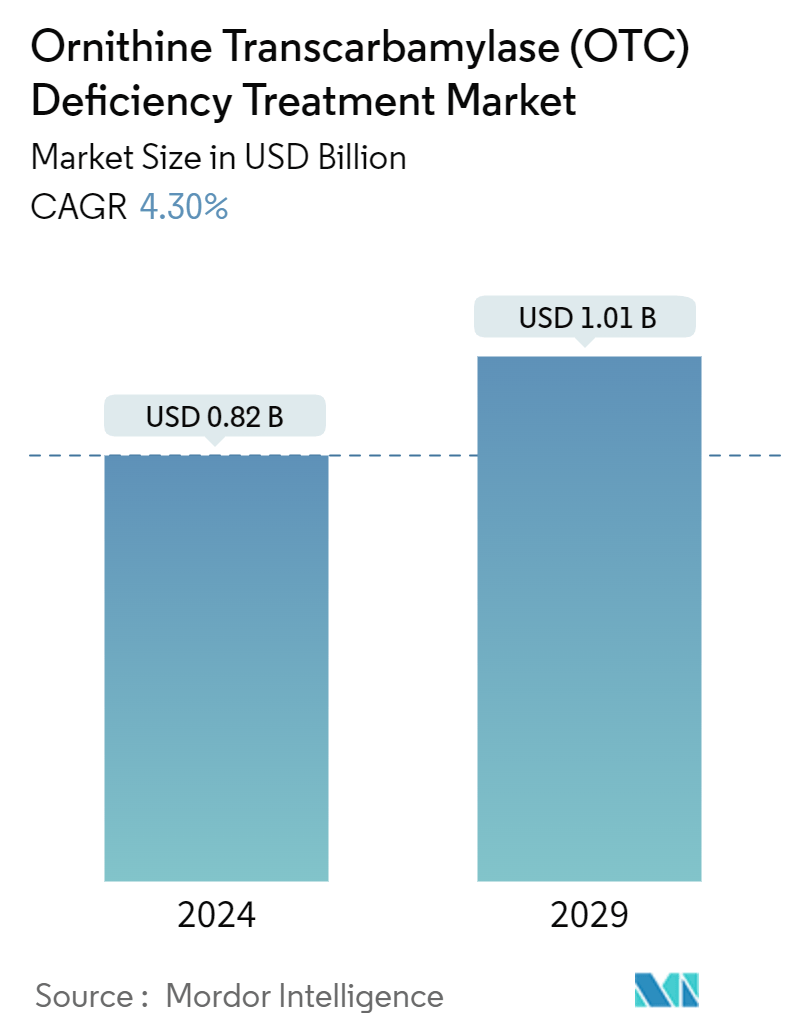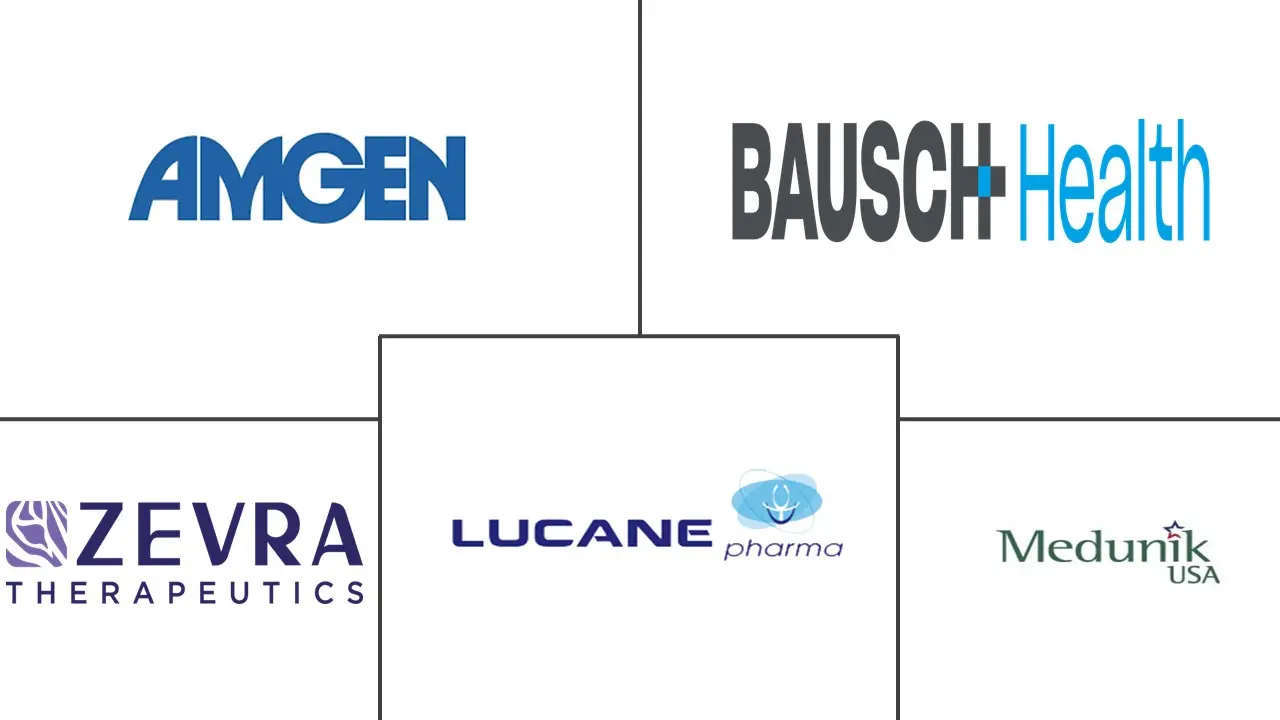Market Size of Ornithine Transcarbamylase (OTC) Deficiency Treatment Industry

| Study Period | 2019 - 2029 |
| Market Size (2024) | USD 0.82 Billion |
| Market Size (2029) | USD 1.01 Billion |
| CAGR (2024 - 2029) | 4.30 % |
| Fastest Growing Market | Asia Pacific |
| Largest Market | North America |
| Market Concentration | High |
Major Players
*Disclaimer: Major Players sorted in no particular order |
Ornithine Transcarbamylase Deficiency Treatment Market Analysis
The Ornithine Transcarbamylase Deficiency Treatment Market size is estimated at USD 0.82 billion in 2024, and is expected to reach USD 1.01 billion by 2029, growing at a CAGR of 4.30% during the forecast period (2024-2029).
Ornithine transcarbamylase (OTC) deficiency is a rare X-linked genetic disorder showing a complete or partial lack of the ornithine transcarbamylase (OTC) enzyme. The rising approvals for novel pipeline products for ornithine transcarbamylase (OTC) deficiency treatment are expected to influence market growth. In March 2024, iECURE received the Medicines & Healthcare Products Regulatory Agency (MHRA) approval for its clinical trial authorization application (CTA) to expand the phase I/II OTC-HOPE clinical trial of its investigational gene editing-based therapy, ECUR-506, in the United Kingdom.
In addition, in August 2023, Bloomsbury Genetic Therapies Limited received orphan drug designation from the US Food and Drug Administration (FDA) for the company's investigational liver-targeted gene therapy, BGT-OTCD, for the treatment of ornithine transcarbamylase deficiency.
Furthermore, growing awareness for ornithine transcarbamylase deficiency disease and increasing campaigns organized by public and private entities are expected to fuel market growth. For instance, the NIH's National Center for Advancing Translational Sciences (NCATS) and the NIH Clinical Center sponsor the event, Rare Disease Day, on the last day of February, i.e., 28 or 29, as a part of the global Rare Disease Day observance every year. This day celebrates and includes raising awareness about rare diseases, the people they affect, etc. NIH conducted this event on February 29, 2024, and held it in person at the NIH Main Campus (Natcher Conference Center), Bethesda, United States.
In addition, favorable reimbursement scenarios in developed countries and patient assistance programs, particularly in developing regions, have also been fueling the growth of the OTC deficiency treatment market in recent years. For instance, in January 2024, Medunik USA, a member of Duchesnay Pharmaceutical Group (DPG), announced that Pheburane coverage is added to the Medicaid Preferred Drug List in 10 states with the recent addition of Indiana, Tennessee, Georgia, and Missouri, along with those already in effect in New Hampshire, New Mexico, North Dakota, Oklahoma, Texas, and Utah. Pheburane is also included on the California Contract Drugs List, and no prior authorization is required for the drug. Hence, it is easily accessible to patients with reimbursement. The drug is covered by commercial insurance plans, mainly offered by private players, and is covered by employers, which constitutes around 80% of the total commercially insured US population.
Medunik USA offers a patient program called the UNIK Support Program for Pheburanr, which provides specialized services, including a copay savings program, patient care liaison services, mail-order pharmacy, and other support services. Thus, the factors above are expected to boost the market growth.
However, the high cost of drugs, limited budget, and less awareness of disease and treatment in lower-income countries may restrain the market growth.
Ornithine Transcarbamylase Deficiency Treatment Industry Segmentation
Ornithine transcarbamylase deficiency is a rare genetic condition that results in ammonia building up in the blood. This condition is more prominently seen in boys than girls and tends to be more severe when symptoms emerge shortly after birth. Ornithine transcarbamylase deficiency is caused by changes in the OTC gene, which instructs the body to make the OTC enzyme. In OTC deficiency, the OTC gene is either damaged or missing.
The ornithine transcarbamylase (OTC) deficiency treatment market is segmented into treatment type, route of administration, distribution channel, and geography. The market is segmented by treatment type into glycerol phenylbutyrate, sodium phenylbutyrate, sodium phenylacetate and sodium benzoate, and other treatment types. By route of administration, the market is segmented into oral and intravenous. By distribution channel, the market is segmented into hospital pharmacies, retail pharmacies, online pharmacies, and other distribution channels. By geography, the market is segmented into North America, Europe, Asia-Pacific, and Rest of the World. The report also offers the market sizes and forecasts for 13 countries across the region. For each segment, the market size and forecast are provided in terms of value (USD).
| By Treatment Type | |
| Glycerol Phenylbutyrate | |
| Sodium Phenylbutyrate | |
| Sodium Phenylacetate and Sodium Benzoate | |
| Other Treatment Types (Gene Therapy, Dietary Supplements, etc.) |
| By Route of Administration | |
| Oral | |
| Intravenous |
| By Distribution Channel | |
| Hospital Pharmacies | |
| Retail Pharmacies | |
| Online Pharmacies | |
| Other Distribution Channels (Specialty Stores, Convenience Stores, etc.) |
| Geography | ||||||||
| ||||||||
| ||||||||
| ||||||||
| Rest of the World |
Ornithine Transcarbamylase (OTC) Deficiency Treatment Market Size Summary
The ornithine transcarbamylase (OTC) deficiency treatment market is poised for growth, driven by the increasing approval of novel therapies and heightened awareness of the condition. OTC deficiency, a rare X-linked genetic disorder, results from a lack of the OTC enzyme, and its treatment landscape is evolving with significant advancements. Recent regulatory approvals, such as iECURE's clinical trial authorization in the UK and Bloomsbury Genetic Therapies' orphan drug designation in the US, are expected to propel market expansion. Additionally, awareness campaigns like Rare Disease Day, sponsored by entities such as the NIH, are contributing to the growing recognition of OTC deficiency. Favorable reimbursement scenarios in developed countries and patient assistance programs in developing regions further support market growth, with companies like Medunik USA enhancing accessibility through programs like the UNIK Support Program.
The market is characterized by the dominance of glycerol phenylbutyrate, particularly RAVICTI, due to its improved patient compliance compared to other treatments. The drug's nearly odorless and tasteless formulation has led to a shift from sodium phenylbutyrate, boosting its market presence. North America is expected to lead the market, supported by product approvals, clinical trials, and favorable reimbursement conditions. The region benefits from robust patient assistance programs, such as the NUCDF Mentor Program, which provide essential support to families affected by OTC deficiency. The competitive landscape is consolidated, with key players like Amgen Inc., Bausch Health Companies Inc., and Ultragenyx Pharmaceutical Inc. holding significant market shares. Recent strategic moves, such as Zevra Therapeutics' acquisition of Acer Therapeutics and Amgen's acquisition of Horizon Therapeutics, underscore the focus on expanding rare disease portfolios, further shaping the market dynamics.
Ornithine Transcarbamylase (OTC) Deficiency Treatment Market Size - Table of Contents
-
1. MARKET DYNAMICS
-
1.1 Market Overview
-
1.2 Market Drivers
-
1.2.1 Rising Product Approvals With Novel Pipeline Products for Ornithine Transcarbamylase (OTC) Deficiency Treatment
-
1.2.2 Growing Awareness for Disease with Campaigns Organized by Public and Private Entities
-
1.2.3 Favorable Reimbursement Scenario and Patient Assistance Programs
-
-
1.3 Market Restraints
-
1.3.1 High Cost of Drugs and Limited Budget
-
-
1.4 Porter's Five Forces Analysis
-
1.4.1 Threat of New Entrants
-
1.4.2 Bargaining Power of Buyers/Consumers
-
1.4.3 Bargaining Power of Suppliers
-
1.4.4 Threat of Substitute Products
-
1.4.5 Intensity of Competitive Rivalry
-
-
-
2. MARKET SEGMENTATION (Market Size by Value - USD)
-
2.1 By Treatment Type
-
2.1.1 Glycerol Phenylbutyrate
-
2.1.2 Sodium Phenylbutyrate
-
2.1.3 Sodium Phenylacetate and Sodium Benzoate
-
2.1.4 Other Treatment Types (Gene Therapy, Dietary Supplements, etc.)
-
-
2.2 By Route of Administration
-
2.2.1 Oral
-
2.2.2 Intravenous
-
-
2.3 By Distribution Channel
-
2.3.1 Hospital Pharmacies
-
2.3.2 Retail Pharmacies
-
2.3.3 Online Pharmacies
-
2.3.4 Other Distribution Channels (Specialty Stores, Convenience Stores, etc.)
-
-
2.4 Geography
-
2.4.1 North America
-
2.4.1.1 United States
-
2.4.1.2 Canada
-
2.4.1.3 Mexico
-
-
2.4.2 Europe
-
2.4.2.1 Germany
-
2.4.2.2 United Kingdom
-
2.4.2.3 France
-
2.4.2.4 Italy
-
2.4.2.5 Spain
-
2.4.2.6 Rest of Europe
-
-
2.4.3 Asia-Pacific
-
2.4.3.1 China
-
2.4.3.2 Japan
-
2.4.3.3 India
-
2.4.3.4 Australia
-
2.4.3.5 South Korea
-
2.4.3.6 Rest of Asia-Pacific
-
-
2.4.4 Rest of the World
-
-
Ornithine Transcarbamylase (OTC) Deficiency Treatment Market Size FAQs
How big is the Ornithine Transcarbamylase Deficiency Treatment Market?
The Ornithine Transcarbamylase Deficiency Treatment Market size is expected to reach USD 0.82 billion in 2024 and grow at a CAGR of 4.30% to reach USD 1.01 billion by 2029.
What is the current Ornithine Transcarbamylase Deficiency Treatment Market size?
In 2024, the Ornithine Transcarbamylase Deficiency Treatment Market size is expected to reach USD 0.82 billion.

